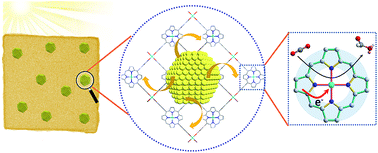A simple strategy for engineering heterostructures of Au nanoparticle-loaded metal–organic framework nanosheets to achieve plasmon-enhanced photocatalytic CO2 conversion under visible light†
Abstract
Carbon dioxide selectively concentrated in micropores of metal–organic frameworks (MOFs) and light absorption units as bridged ligands or guest molecules incorporated into MOF matrices are positive effects on upgrading reactivity of metal catalytic centers towards CO2 conversion through high-efficient quasi-intramolecular electron transfer among them. However, in contrast to the surfaces of MOFs, sluggish mass transfer of CO2, as well as of products, in micropores could negatively affect photocatalytic activity for CO2 reduction. Moreover, interactions between light and matter are heavily blocked if light absorption units are buried deep in bulky MOF matrices. In this research, hybrids of thin porphyrin paddle-wheel framework-3 (PPF-3) nanosheets (PPF-3_1) anchored with AuNPs are prepared by an electrostatic interaction to address these questions. This mainly involves improvement of PPF-3 morphology and the assembly mode between Au nanoparticles (AuNPs) and PPF-3 nanosheets. On the one hand, thin nanosheets can induce faster charge transfer rate and higher mass transport capability than thick nanosheets in the photocatalytic process; on the other hand, plasmonic AuNPs loaded onto the surfaces of nanosheets lead to more effective light absorption than AuNPs encapsulated in the matrices of nanosheets. Finally, the hybrids exhibit superior photocatalytic activity for CO2 conversion into HCOOH in an acetonitrile/ethanol system by plasmon resonance energy transfer process compared with pure PPF-3_1 or hybrids of thick PPF-3 nanosheets (PPF-3_2) supporting AuNPs. The research offers a novel and universal strategy to build high-efficiency MOF-based photocatalysts with enhanced performance for selective photocatalytic CO2 reduction.



 Please wait while we load your content...
Please wait while we load your content...